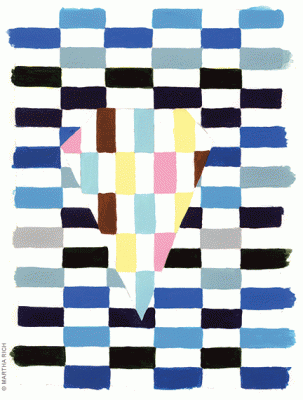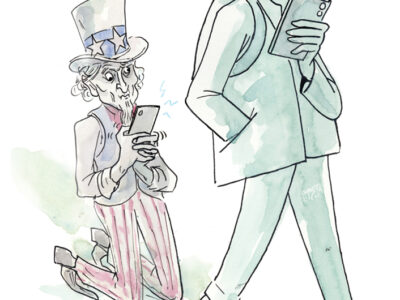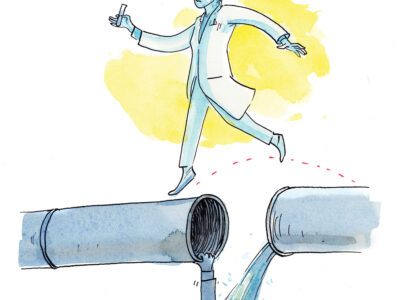
How to buy a diamond like a diamond dealer.
By Ira Weissman
il·lu·sion, noun. 1. Something that deceives by producing a false or misleading impression of reality. 2. A projection of value onto an object (usually a diamond) based solely on subjective psychological criteria, not any objective standard of measurement: When I bought this diamond, I had tons of illusion in it; now that it’s been sitting in my safe for months, I’m beginning to lose my illusion.
While the first definition above has Webster’s imprimatur, the second one has bigger implications for your bank account.
Like many self-contained industries, the diamond business has its own language. Part Yiddish, part Hebrew, part Hindi, part Farsi, part English, this jargon is the grease that has kept the international diamond commerce machine chugging along for the past century. And illusion is the most revealing term in the trade.
You might think that when two diamond dealers sit down across from one another to negotiate the exchange of a stone, all that ensues is a simple back-and-forth argument over its objective merits and defects. But this is not the case. What actually transpires is a psychological battle, a war over the perceived value of the stone.
You see, when a dealer owns a diamond, it’s not just another emotionless asset that he’s invested in. Any diamond dealer will tell you that when he buys a diamond, he loves that diamond. He believes his diamond is the nicest diamond he’s ever seen in that particular color and class of clarity. He has built up a lot of illusion in the stone.
So what’s the first thing a prospective buyer will do when he looks at the stone? If, and only if, he’s interested in buying the stone, he’ll begin to talk out loud, with the diamond in tweezers held up to the loupe against his eye, about everything he can spot that’s wrong about it. If he doesn’t see any cause for criticism, he’ll happily make something up. His job is to break the owner’s illusion in the stone.
It is a fascinating irony that the diamond trade’s central players speak so much, and so openly, about illusion. After all, the industry has staked its entire existence on the notion that a diamond’s value is intrinsic, measurable, and lasts forever. Diamond dealers, of course, know all about the illusory nature of a stone’s value; but that is of little concern to them, for they exist within the bubble and depend upon it for their livelihood. What’s truly amazing is that even within the diamond ecosystem, there is a recognition that emotion and perception are what ultimately determine price.
What lies behind this diamond illusion, exactly? Seventy-five years of ingenious manipulation of old-fashioned gender roles. Men justify buying diamonds because they believe in a diamond’s ever-increasing value. But the notion of ever-increasing value depends entirely on women’s desire for them, and a shared belief that their supply is restricted.
It’s an ingenious marketing tautology created by the De Beers cartel as a way to profit from the massive stockpiles of diamonds discovered in South Africa in the late 1800s. Their breakthrough, the 1947 “A Diamond is Forever” advertising campaign—often ranked among the most successful of all time—is so remarkable because it simultaneously speaks on two levels. To a woman, the phrase implies that a diamond represents her man’s perpetual love. To a man, it suggests that a diamond’s value is imperishable—while at the same time hinting that one should never be sold on the secondary market (because, of course, it is forever).
It may be hard to believe, but before the N.W. Ayer advertising agency coined that juggernaut slogan, diamond engagement rings were the exception, not the rule, in the United States and Europe. As investigative journalist Edward Jay Epstein recounted in The Atlantic in 1982, N.W. Ayer advised De Beers that “[w]e are dealing with a problem in mass psychology. We seek to … strengthen the tradition of the diamond engagement ring—to make it a psychological necessity [for] some 70 million people 15 years and over.”
In addition to traditional media, the agency targeted adolescent girls directly, sending “lecturers” directly into the schools they attended. “All of these lectures revolve around the diamond engagement ring, and are reaching thousands of girls in their assemblies, classes, and informal meetings in our leading educational institutions,” the agency explained in a memorandum to De Beers.
So what is a modern man to do? It’s been many decades since De Beers began telling their story, and let’s face it: they won. As The New York Times reported last year, even after 15 years of media exposés about “blood diamonds” and bad conditions in mines, some 75 percent of American brides wear diamond engagement rings. Skepticism can be a tricky proposition. If you’ve been dating and you’re ready to marry, is it advisable to preface a proposal with a lecture about the history of De Beers and the diamond illusion? Clearly that’s a personal question—though even there, the expectations of friends and family exert a powerful pressure of their own.
If you strip away the illusion from the diamond, you’re left with a simple retail product like any other, with features and benefits. Whether or not it is truly forever, a well-cut diamond is no doubt a beautiful object. And that is the thing to bear in mind above all else. If you only buy a diamond for its beauty—not its symbolism, or the status you hope it might confer, or a misplaced hope for a return on the “investment”—you can get away with spending much less than those beholden to the illusion.
Indeed, when a diamond dealer wishes to buy a diamond as a personal gift, this is exactly the path he will take. It’s one thing to speak of illusion when buying a diamond that he intends to resell for a profit, but when buying a diamond for his wife, there is no illusion at all: he wants to spend the least amount possible while getting something that will look wonderful.
So how can you do the same? Well, if you’re not focused on boosting your ego by spending a lot of money, then the clearest way to save money is to buy online. The best online vendors sell the exact same product as the top big-name retailers, just for much less money. [Disclosure: My business assists diamond buyers in the online marketplace.] The reason is quite simple: unlike brick and mortar retailers, online vendors do not need to own any diamond inventory. Diamonds are a slow-turnover, high-value product that requires a major investment to finance even a minimal inventory. Classic retailers need to charge a significant profit margin to overcome this built-in disadvantage. Is it worth spending a 30 to 50 percent premium just to get the ring delivered in a “little blue box”? Only if you believe the illusion that spending more money means you love her more.
If your only concern is the diamond’s beauty, it follows that spending any additional money for better “features” that don’t actually translate into any tangible benefits is a complete waste. To be more specific, if a low-clarity diamond looks identical, to the naked eye, to a flawless diamond, then flawlessness is a feature without any benefit.
It is an underappreciated fact that, all else being equal, a low-clarity diamond (i.e., more and larger imperfections) that is still nice enough to look “clean” to the naked eye (meaning that magnification is required to reveal imperfections), will look identical to a flawless diamond. The difference in price can be astounding. A one-carat round G-color ideal-cut flawless diamond will cost about $11,000—double what an eye-clean SI2 will cost. (Clarity grades are Flawless, VVS1, VVS2, VS1, VS2, SI1, SI2, and I1.) That’s a $5,500 difference.
And what about color? That’s not quite as straightforward as clarity. Diamonds are graded for color on a scale from D, indicating perfect colorlessness, to Z, light yellow. And though an H-color diamond will appear ever so slightly warmer than a D if they are placed next to one another, you’d be very hard-pressed to notice any tint at all in an H on its own. And when you compare an H to an F or G, it’s nearly impossible to tell any difference at all. As opposed to clarity, we can’t say that there’s no benefit to splurging for an ultra-high color grade; it’s just a barely noticeable one. And perhaps not noticeable enough to justify a price difference of 25 percent or more.
An online shopper with a savvy approach to clarity and color can save a great deal of money. Recently I was quoted $30,100 for a 1.03 carat round plain solitaire engagement ring from Tiffany & Co. in E color and VVS1 clarity. A similarly set 1-carat stone online, in an I color and (eye-clean) SI2 clarity costs under $5,000. The only difference would be a slightly warmer shade of white.
I do hope that future generations can break free from the hold the diamond illusion has over all of us. Spending two months’ salary on this artificial symbol of love at such a critical time in a man and woman’s life together just does not seem right. But until that day arrives, I hope everyone can at least learn to buy a diamond for its beauty and not for its illusion.
Ira Weissman W’00’s career in the diamond trade has ranged from the polishing factory and sorting rooms to online affiliate marketing through www.Diamonds.pro. He lives in Israel with his wife and six children.





Finally someone recognizes the insanity of paying for something that only has illusory value. If you can’t tell the difference between a flawless diamond and a less perfect one – why pay for perfection? I may even take the argument further and say if you can’t tell the difference between a diamond and cubic zirconia, why pay for a diamond? And by extension, if you can’t tell the difference between an antique and a modern reproduction, then why pay for an antique?
Cubic Zirconias are soft and scratch easily hence the reason they are not really competition to the more durable diamond.